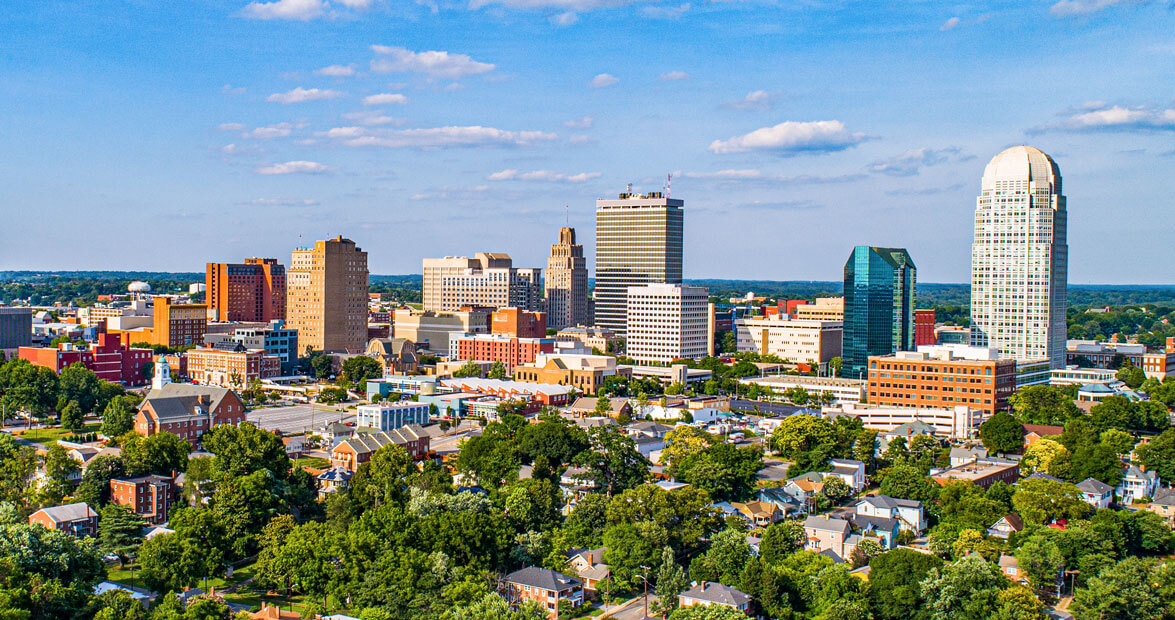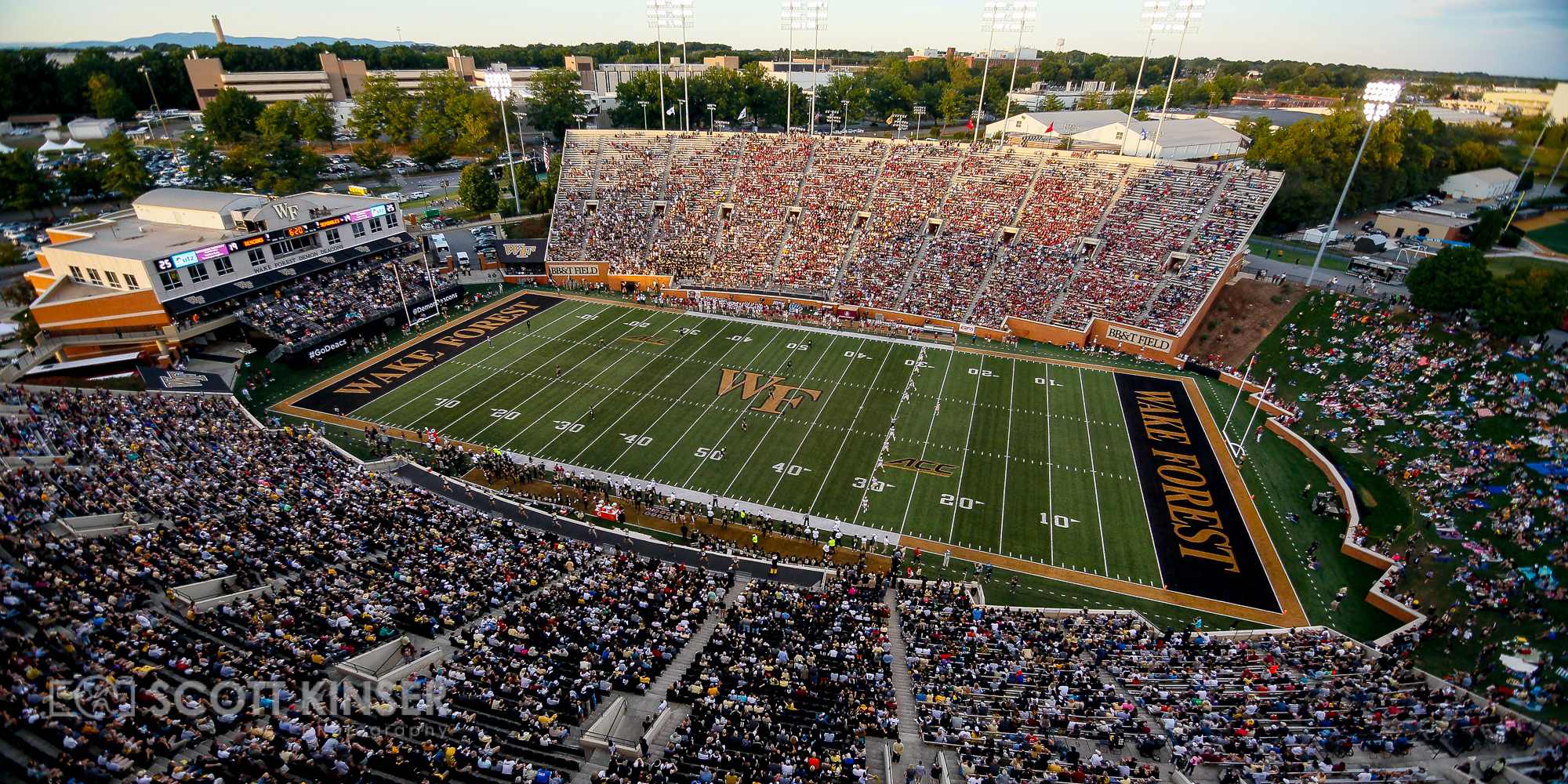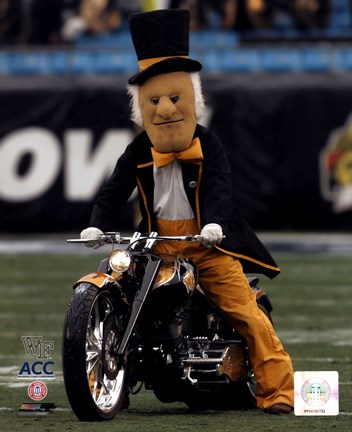This Friday night, Wake Forest University open their 2021 football season at home, at Truist Field in Winston-Salem, North Carolina, against Old Dominion University of Norfolk, Virginia.
Like ODU, Wake Forest, the Demon Deacons, are better known for basketball than for football. But I pledged myself to do all the major college football conferences' teams, and Wake Forest are the last Atlantic Coast Conference team that I haven't yet done.
Winston-Salem is in the Eastern Time Zone, so you won't have to fiddle with your timepieces. It is in North Carolina, a former Confederate State, but you won't need your passport or to change your money.
Wake Forest's stadium seats only 31,500. But they don't always fill it. Tickets should be easy to get. They cost $41.
Getting There. It's 567 miles from Midtown Manhattan to the Wake Forest campus. It's in that tricky range: A bit too close to fly, a bit too far to go any other way.
If you're going to drive, take the New Jersey Turnpike/Interstate 95 South all the way from New Jersey to Petersburg, Virginia. There, Interstate 85 will split off. Take that South to Exit 131. Take Interstate 40 East, and Exit 206 will put you on U.S. Route 421 West. From there, it's 14 miles west to Winston-Salem.
You'll be in New Jersey for about an hour and a half, Delaware for 20 minutes, Maryland for 2 hours, inside the Capital Beltway (Maryland, District of Columbia and Virginia) for half an hour if you're lucky (and don't make a rest stop anywhere near D.C.), Virginia for 3 hours, and North Carolina for 2 1/2 hours. Throw in traffic at each end, rest stops, preferably in Delaware, near Richmond and near Raleigh, and it'll be close to 13 hours.
Greyhound, round-trip to Winston-Salem, costs as much as $479 round-trip, though it can be as low as $277 on advanced purchase. The trip takes 13 hours, including a long layover to change buses in Richmond. The station is at 2210 Capital Blvd., 3 miles northeast of downtown. Take the Number 1 or 3 bus in.
Amtrak's Carolinian leaves Newark's Penn Station at 7:25 AM, and arrives at the Clark Campbell Transportation Center in Winston-Salem at 8:50 PM. Round-trip fare is $287 even. The station is at 100 W. 5th Street, downtown, 3 miles south of the stadium. Take the Number 106 bus in.
Perhaps the best way to get there is by plane. If you fly United Airlines out of Newark, and you order your ticket online at this writing, you could get a nonstop round-trip flight for $467. Even then, it's 86 miles from Douglas International Airport in Charlotte to the Wake Forest stadium, and 96 miles from Raleigh-Durham International Airport. You'd have to rent a car.
Once In the City. Both North Carolina and South Carolina were named for the King of England at the time of their initial settlements, King Charles I. Salem was founded in 1796, named for Salem, Massachusetts. Winston was founded in 1849, and named for Joseph Winston, a hero of the American Revolution, a cousin of Patrick Henry, and an early Congressman. The towns were consolidated in 1913. Today, Winston-Salem has a population about 250,000.
The R.J. Reynolds Tobacco Company was the biggest developer of the combined town, producing cigarette brands named Winston (with a familiar red box) and Salem (with a green box). Their most popular brand, however, was Camel, the brand my grandfather smoked to his death. And so, Winston-Salem is known as the Camel City.
The aforementioned Campbell Transportation Center is the base of the buses of the Winston-Salem Transit Authority. A ride is just $1.00. Main Street is the East-West divider, and 1st Street is the North-South divider.
The sales tax in North Carolina is 4.75 percent. ZIP Codes for Winston-Salem start with the digits 271. The Area Code for the area is 336. There is no "beltway" for the area. Duke Energy runs the local electricity, and Piedmont Natural Gas the heat. The main newspaper is the Winston-Salem Journal. The area is about 48 percent white, 35 percent black, 15 percent Hispanic and 2 percent Asian.
North Carolina is known for its beaches on "The Outer Banks," or "OBX." This includes Kill Devil Hill, with the Wright Brothers National Memorial, on roughly the location where Orville Wright, with brother Wilbur Wright watching, took off in Flyer I on December 17, 1903, marking the 1st heavier-than-air human flight. The Outer Banks are centered on Nags Head, about 300 miles to the east.
Once On Campus. Wake Forest Manual Labor Institute was founded in 1834, and became Wake Forest College in 1839, and Wake Forest University in 1967. Until 1941, the school was actually in Wake Forest, North Carolina, north of Raleigh, which is in Wake County.
Although the school is geared toward North Carolinians, it is not limited to them. Their alumni from outside of sports include:
* Journalism: Al Hunt and Melissa Harris-Perry, both of MSNBC.
* Entertainment: Carroll O'Connor started there, but dropped out due to World War II and never returned. Sopranos creator David Chase also dropped out.
* Politics, from North Carolina unless otherwise stated: Governors William Kitchin, J. Melville Broughton, Bob Ehrlich of Maryland and Charlie Crist of Florida; Senators Josiah Bailey, Furnifold Simmons, Bob Morgan, Jesse Helms, Kay Hagan and Richard Burr.
Their best sport is basketball, having produced Billy Packer, who played for their Final Four team of 1962 and then became one of the sport's great broadcasters; Charlie Davis, Tyrone "Muggsy" Bogues, Rodney Rogers, Josh Howard, Hall-of-Famer Tim Duncan, and probable future Hall-of-Famer Chris Paul. In other sports:
* Baseball: Yankee World Series winners Tommy Byrne, Ray Scraborough, Rip Coleman and Mike Buddie; as well as Willard Marshall, Erik Hanson and Ryan Braun.
* Soccer: Michael Parkhurst.
Going In. The official address of Truist Field at Wake Forest is 411 Deacon Boulevard, about 3 miles north of downtown, and about a mile and a half east of the main campus. Parking is $15. If you're using public transportation, use Bus 106. The field is aligned northwest to southeast, and has been artificial, FieldTurf, since 2006. The Southeast end is a grassy area known as Deacon Hill.

The stadium opened in 1968 as Groves Stadium, named for its financiers, brothers Harry and Earl Groves. In 2006, BB&T, a bank headquartered in North Carolina, announced it would finance upgrades to the facility, and it was known as BB&T Field until 2020, when Truist Bank bought BB&T and the naming rights. Despite the upgrades, seating capacity is still listed as only 31,500, making it barely enough to qualify for the Football Bowl Subdivision.
Food. This is the South, tailgate party country, and North Carolina is among the places in this country particularly known for good barbecue. According to the website
Stadium Journey (which hasn't been updated to include the stadium's new name):
BB&T Field offers a wide range of food offerings from its concession stands and the increasingly popular food trucks. The main concessions stands offer Nathan’s Hot Dogs, chicken tenders, and a cheeseburger basket (with fries) at eight, nine, and eleven dollars respectively, as well as various snacks for five dollars; Chick-fil-A sandwiches and Domino’s Pizza are also offered.
There are also Pepsi products, with a regular fountain soda size for three dollars, a bottled soda for five dollars, and a souvenir option for six. Coffee is also offered for three dollars, while canned domestic beer such as Budweiser and Miller Lite go for eight dollars, and for seven dollars you can get a bottle of the local brew Foothills. There are also numerous places throughout the stadium to get domestic and local brews if you don’t feel like standing in line at the concession stands.
Going beyond the main stands, there are some local favorites such as Henry’s Gourmet Popcorn Shop, Hoka Hey Legendary Popcorn, and Ghassan’s Fresh Mediterranean Eats which serves up gyros, pitas, and more. Another favorite local food truck is Curb Your Appetite which offers a Curbside Soul Burger, which is a burger stuffed with peppers and onions and the eatery’s own seasonings with your choice of toppings. Other options from this truck include a 24-hour marinated ribeye steak sandwich, a club sandwich, a three-cheese grilled cheese sandwich, and a chicken or Philly Cheesesteak sandwich; this food truck is truly a place to check out.
Finally, the Greensboro based Porterhouse Burger Truck offers a variety of burgers, including the Twisted Carolina, the Jam-Tastic, and the “Some Like It Hot” Burger. My personal favorite is “The Big Lebowski” Burger, which at thirteen dollars is a little more expensive than the other options but comes with everything the truck has and tastes delicious. This truck also serves other sandwiches as well as pulled pork egg rolls and fries.
And, if you have room for dessert there is a stand selling funnel cakes and Dippin’ Dots, but the two main highlights are a Duck Donuts truck outside the stadium and Chewy on Top, which offers funnel cake bites and sticks. In addition, Chewy offers four types of funnel cake, fried Oreos, cinnamon roll bites, and a brownie sundae – truly something for everyone with any sort of sweet tooth.
Team History Displays. Wake Forest have been playing football since 1888, but without much success. Their all-time record of 465-665-33 (.414) is one of the worst in FBS. They were members of the Southern Conference from 1936 to 1952, and never won its title. They are charter members of the Atlantic Coast Conference (ACC, founded in 1953), and have won it only twice, in 1970 and 2006.
They've had better luck in bowl games, reaching 15, and winning 9. They won the 1st-ever Gator Bowl in 1946, beating South Carolina in Jacksonville. Then they lost the 1949 Dixie Bowl, and never made it to another bowl until losing the 1979 Tangerine Bowl.
But they won the 1992 Independence Bowl, the 1999 Aloha Bowl, the 2002 Seattle Bowl, the 2007 Meineke Car Care Bowl, the 2008 EagleBank Bowl, the 2016 Military Bowl, the 2017 Belk Bowl, and the 2018 Birmingham Bowl. But they haven't played in any of the bowls traditionally played on New Year's Day since that 1st Gator Bowl.
They have 5 retired numbers: 16, for 1950s quarterback Norm Snead; 19, for 1970s defensive back Bill Armstrong; 31, for 1960s running back Brian Piccolo (made legendary by his fatal illness and his friendship with Chicago Bears teammate Gale Sayers); 33, for 1950s running back Billy Ray Barnes; and 47, for 1940s linebacker Bill George.
Other notable Wake Forest football players include former Giants executive Ernie Accorsi, Giants' Super Bowl XXI-winning guard Billy Ard, former Jets linebacker Calvin Pace, Pittsburgh Super Bowl IX & X-winning center Jim Clack, Edmonton Grey Cup-winning linebacker James "Quick" Parker, St. Louis and Indianapolis Super Bowl-winning receiver Ricky Proehl (of Hillsborough, Somerset County, New Jersey), Baltimore Super Bowl XXXV-winning defensive end Michael McCrary, and New Orleans Super Bowl XLIV-winning safety and now Jets assistant coach Chip Vaughn. Senator Richard Burr of North Carolina and former Governor Charlie Crist of Florida also played football at Wake Forest.
Perhaps Wake Forest's proudest football achievement is sweeping their three "Tobacco Road" rivals -- Duke, North Carolina and North Carolina State -- 8 times: In 1924, 1951, 1970, 1984, 1987, 2006, 2007 and 2019.
The 1st college football game in North Carolina was played on October 18, 1888, and Wake Forest beat North Carolina 6-4. That said, UNC leads the rivalry 68-36-2. N.C. State leads Wake Forest 67-41-6. The rivalry with Duke is closer, but Duke still leads 58-40-2.
Stuff. There is no big team store at the stadium, just small souvenir stands. Your best bet is to go to the University's Taylor Bookstore, at 1834 Wake Forest Road. There are no notable books or DVDs about Wake Forest football.
During the Game. Wake Forest fans are not known for being rough. As long as you remain civil, so will they.
The teams are called the Demon Deacons. This would seem to be a contradiction. The school was founded by Baptists, so the "Deacon" part is easy to understand. In 1923, Wake Forest beat Trinity, soon to be renamed Duke, and the editor of the school paper, Mayon Parker, called them "Demon Deacons," saying they had "devilish play." The school's head football and basketball coach, Hank Garrity, and its publicity director, Henry Belk, both liked it, and the name stuck.
In 1941, WF junior Jack Baldwin put on an old tuxedo and top hat, and became the 1st Demon Deacon mascot. Eventually, the Deacon became a costume with a big foam head, and his suit became black and gold to match the school's colors. Oddly, he rides a motorcycle onto the field (perhaps part of the "Demon" image), and even has a statue outside the stadium.
The Marching Band is known as the Spirit Of The Old Gold And Black, or "SOTOGAB." The fight song is "Here's to Wake Forest."
After the Game. You will most likely be safe. If you drove in, so should your car. Finding a good postgame meal shouldn't be difficult. About a block west of the stadium is a restaurant called the Last Resort. Another block west of that is University Parkway, with several chain restaurants.
If you're a fan of a European soccer team, your best bet to watch them is at Small Batch Beer Company, at 241 W. 5th Street, downtown.
Sidelights. From 1940 to 1955, Wake Forest played at Groves Stadium, behind Wake Forest High School, at 420 W. Stadium Avenue, in Wake Forest, which is closer to Raleigh. As I said, the University moved to a new campus, not long after that stadium opened. This stadium is now named Trentini Stadium, after a WFHS player.
From 1956 to 1967, the Demon Deacons played at Bowman Gray Stadium. They had first played there in 1937, but the facility's most common event is stock car racings. It seats only 17,000 people, hence WF's need for a bigger stadium, although Truist Field isn't even twice as big.
They also needed a stadium closer to campus: Bowman Gray is at 1250 S. Martin Luther King Jr. Drive, 6 miles southeast of the campus, 5 miles southeast of Truist Field, and 2 miles southeast of downtown. From there, take Bus 86. The campus of Winston-Salem State University, a historically black school, is adjacent.
Wake Forest's much more successful basketball program plays at the Lawrence Joel Veterans Memorial Coliseum, at 2825 University Parkway, across Deacon Boulevard from Truist Field. The Coliseum opened in 1989, and seats 14,665.
The Demon Deacons have won the Conference regular-season Championship in 1939, 1960, 1962, 1995 and 2003; the ACC Tournament in 1953, 1961, 1962, 1995 and 1996; both in 1962 and 1995; and reached the NCAA Final Four in 1962.
Naming the arena for Joel was a big step, because it made WF one of the few schools in major college sports with a stadium or arena named for a black person, and in the South, no less. Lawrence Joel was a medic who was awarded the Silver Star and the Congressional Medal of Honor for his actions in Vietnam on November 8, 1965. He was the 1st living black person to receive the Medal of Honor since the Spanish-American War in 1898.
Specialist 6th Class Lawrence Joel, U.S. Army,
receiving his Medal of Honor citation
from President Lyndon B. Johnson, March 9, 1967.
Since he was a Winston-Salem native, the city gave him a parade after he received the medal in 1967. Diabetes did what the Vietcong could not, ending his life in 1984. He is buried in Arlington National Cemetery.
Winston-Salem has a long history of minor-league baseball. Their teams were usually called the Twins, since Winston and Salem had previously been "twin cities," like Minneapolis and St. Paul. The Winston-Salem Twins won Pennants in 1928, 1950 and 1951. The Winston-Salem Red Sox won Pennants in 1964, 1970 and 1973, and helped build the Boston Red Sox Pennant winners of 1967 and 1975. The Winston-Salem Spirits won the Pennant in 1986. The Winston-Salem Warthogs won the most recent of the city's 9 Pennants in 2003.
From 1945 to 1956, they played at South Side Park, at 1533 S. Main Street, about 2 miles south of downtown. Bus 104 will get you within a few blocks. The North Carolina School of the Arts is on the site now.
From 1957 to 2009, they played at Ernie Shore Field, named for the 1910s Red Sox pitcher, a North Carolina native. After the team left, the University took it over, and renamed it David F. Couch Ballpark, after a WF graduate who made a big donation to the University. 401 Deacon Blvd., just to the east of Truist Field.
Since 2009, the team has been known as the Winston-Salem Dash. Since 2010, they have played at Truist Stadium, at 951 Ballpark Way, at the southwestern edge of downtown.
Wake Forest's closest major league teams are not close. Charlotte, home to the nearest NFL, NBA, and soon MLS teams -- the Carolina Panthers, the Charlotte Hornets, and the 2022 expansion team Charlotte FC, respectively -- is 84 miles to the southwest. Raleigh, home to the nearest NHL team, the Carolina Hurricanes, is 103 miles to the east. And the nearest MLB team, the Atlanta Braves, is a whopping 320 miles to the southwest. Trying another direction won't help: The Washington Nationals are 341 miles to the northeast, and the Cincinnati Reds are 418 miles to the northwest.
Elvis Presley sang 3 shows in 1 day, February 16, 1956, early in his career, at the Carolina Theater in Winston-Salem. It still stands, under the name of the Stevens Center. 405 4th Street NW, downtown.
*
Wake Forest basketball can be successful and fun. Wake Forest football can be fun -- just don't expect success.








No comments:
Post a Comment